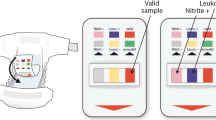Abstract
The high prevalence of urinary tract infection in aging adults is a challenging aspect of geriatric care. Incontinence and cognitive/functional impairment make collection of urine samples difficult and often require either catheterization for sample collection, which is a risk factor for infections, or more lenient criteria for initiating antibiotic treatment. We report the development of a diaper inlay with absorbent materials, superabsorbent polymer-based valve and chemical reaction pads for rapid screening of urinary tract infection of incontinent diaper-wearing elderly receivers of home care services. The developed diaper inlay was capable of collecting, isolating, analyzing samples and retaining results > 8 h. The diaper inlay can therefore be compatible with the diaper changing routines of nurses in home care services, without requiring much time or effort. A nurse can insert a diaper inlay in a diaper and the results can be recorded during a later diaper change. Although the research focuses on tools for home care services, the nursing home sector has similar problems and may benefit from technological development for rapid screening to avoid unnecessary catheterization and overuse of antibiotics.








Similar content being viewed by others
References
Belmin, J., Y. Hervias, E. Avellano, O. Oudart, and I. Durand. Reliability of sampling urine from disposable diapers in elderly incontinent women. J. Am. Geriatr. Soc. 41:1182–1186, 1993.
Cimiotti, J. P., L. H. Aiken, D. M. Sloane, and E. S. Wu. Nurse staffing, burnout, and health care-associated infection. Am. J. Infect. Control. 40:486–490, 2012.
Curtis, E. B., and J. A. Morrow. Inverse problems for electrical networks. Singapore: World Sci., pp. 27–58, 2000.
Devillé, W., J. Yzermans, N. van Duijn, P. Bezemer, D. van der Windt, and L. Bouter. The urine dipstick test useful to rule out infections. A meta-analysis of the accuracy. BMC Urol. 4:1–14, 2004.
Duin, R. P. W., P. Juszczak, P. Paclik, E. Pekalska, D. De Ridder, D. Tax, and S. Verzakov. PRTools 4.1. A Matlab Toolbox for Pattern Recognition, 2010.
Foxman, B. The epidemiology of urinary tract infection. Nat. Rev. Urol. 7:653–660, 2010.
Gorina, Y., S. Schappert, A. Bercovitz, N. Elgaddal, and E. Kramarow. Prevalence of incontinence among older Americans. Vital Health Stat. 3(36):1–33, 2014.
Hamilton-Miller, J. M. T. Issues in urinary tract infections in the elderly. World J. Urol. 17:396–401, 1999.
Hooton, T. M., et al. Diagnosis, prevention, and treatment of catheter-associated urinary tract infection in adults: 2009 international clinical practice guidelines from the infectious diseases society of America. Clin. Infect. Dis. 50:625–663, 2010.
Hothorn, T., and K. Hornik. exactRankTests: exact distributions for rank and permutation tests. R package version 0.8-17, 2006. https://cran.r-project.org/web/packages/exactRankTests/index.html.
Lipsky, B. A. Urinary tract infections in men. Epidemiology, pathophysiology, diagnosis, and treatment. Ann. Intern. Med. 110:138–150, 1989.
Loog, M., R. P. M. Duin, and R. Haeb-Umbach. Multiclass linear dimension reduction by weighted pairwise Fisher criteria. IEEE Trans. Patt. Anal. Mach. Intell. 23:762–766, 2001.
Newcombe, R. G. Two-sided confidence intervals for the single proportion: comparison of seven methods. Stat Med. 17:857–872, 1998.
Nguyen-Van-Tam, S. E., J. S. Nguyen-Van-Tam, S. Myint, and J. C. G. Pearson. Risk factors for hospital-acquired urinary tract infection in a large English teaching hospital: a case-control study. Infection 27:192–197, 1999.
Pezzlo, M. Detection of urinary tract infections by rapid methods. Clin. Microbiol. Rev. 1:268–280, 1988.
Poghosyan, L., S. P. Clarke, M. Finlayson, and L. H. Aiken. Nurse burnout and quality of care: cross-national investigation in six countries. Res. Nurs. Health. 33:288–298, 2010.
Rowe, T. A., and M. Juthani-Mehta. Diagnosis and management of urinary tract infection in older adults. Infect. Dis. Clin. North Am. 28:75–89, 2014.
Scherer, R. PropCIs: Various confidence interval methods for proportions. R package version 0.2–5, 2014.
Skotnes, L. H., R. Omli, U. Romild, O. Hellzèn, and E. Kuhry. Urinary incontinence in Norwegian nursing home residents. Open J. Nurs. 2:116–122, 2012.
Toley, B. J., B. McKenzie, T. Liang, J. R. Buser, P. Yager, and E. Fu. Tunable-delay shunts for paper microfluidic devices. Anal. Chem. 85:11545–11552, 2013.
Acknowledgment
Research supported by: RFF Oslofjordfond projects: (1) Touchsensor for enklere og raskere urinprøvetaking og analyse, no. 234972, (2) Disruptiv Innovasjon for Vannovervåking - Forbedring i Styringen av Vannkvalitet, no. 272037, (3) Papirbasert kolorimetrisk sensorsystem med integrert polymer-lyskilder og -detektorer for kvantitativ deteksjon av biomarkører i spytt, no. 249017, (4) Mikro/nano-strukturerte overflater for in situ evaporeringskjøling ved krevende no. 258902, (5) Analyse av biomarkører i urin med et avansert kolorimetrisk biosensorinnlegg, no. 255893, (6) Smart-tøy for eldreomsorg: Oppfølging av fysiske aktiviteter og overvåkning av fysiologisk status i sanntid, no. 260586. RFF Hovedstaden: Biologisk Vannalarmsystem for å styrke offentlig vannkvalitets-styring No. 273869. Research Council of Norway projects: (1) FORNY2020: SENS-U: Et nytt og tidsbesparende produkt for prøvetaking og analyse av urin i bleie no. 268481, (2) NANO2021, no. 263783. EU Erasmus + Capacity Building in Higher Education: Internationalised Master Degree Education in Nanoelectronics in Asian Universities, no. 573828-EPP-1-2016-1-BG-EPPKA2-CBHE-JP. National Natural Science Foundation of China: (1) no. 61531008, (2) no. 61550110253, (3) 61650410655, (4) 11702045. Chongqing Research Program of Basic Research and Frontier Technology: no. cstc2015jcyjBX0004. Chongqing Innovation Team of Universities and Colleges—Smart Micro-Nano Systems Technology and Application: No. CXTDX201601025. Chongqing Education Commission - Science and Technology Research Program: (1) No. KJ1600602, (2) No. KJ15006XX. Chongqing Science and Technology Commission - the Leader of Science and Technology Innovation: no. CSTCCXLJRC201702. The 13th Recruitment Program of Global Experts (known as “the Thousand Talents Plan”), the Recruitment Program for Innovative Talents Chinese government, Xinjiang University, Tao DONG.
Conflict of interest
No conflicts of interest to report.
Author information
Authors and Affiliations
Corresponding author
Additional information
Associate Editor Tingrui Pan oversaw the review of this article.
Rights and permissions
About this article
Cite this article
Karlsen, H., Dong, T. & Suo, Z. A Diaper Pad for Diaper-Based Urine Collection and Colorimetric Screening of Urinary Biomarkers. Ann Biomed Eng 46, 717–725 (2018). https://doi.org/10.1007/s10439-018-1996-8
Received:
Accepted:
Published:
Issue Date:
DOI: https://doi.org/10.1007/s10439-018-1996-8




